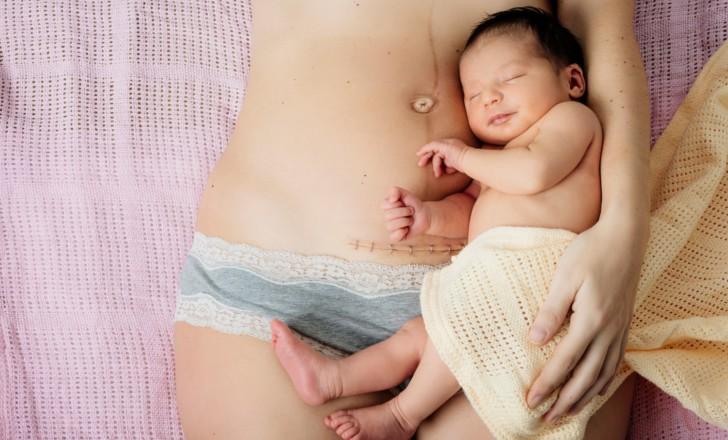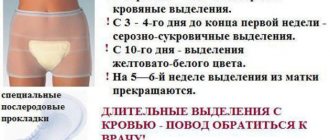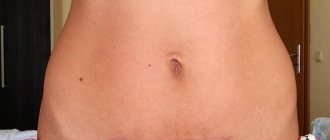The duration of the postpartum period is forty-two days . Immediately after childbirth, a woman experiences spotting. These discharges differ in their properties: at the beginning they are abundant and bright red, but gradually, every day they decrease and, as a rule, by the end of 6-7 they become scanty and acquire a light yellow color.
Postpartum discharge usually stops between the sixth and seventh week after birth. Some women believe that this is menstrual flow, but this is not true at all.
When does your period start after childbirth? The time when your first period starts depends largely on whether you are breastfeeding. If a woman does not breastfeed, her period will begin in about six to eight weeks.
All this happens because those women who do not breastfeed do not produce the hormone prolactin, which is secreted in breastfeeding women. This is why menstruation after childbirth in breastfeeding women usually begins later: for some, after a few months, while breastfeeding continues, for others, after the complete cessation of lactation, and for others, 6-8 weeks after childbirth Everything is very individual and depends on the characteristics of the female body.
The first menstruation is usually anovulatory. That is, the follicle (the sac that contains the egg) has matured, but the egg does not come out of it. Therefore, this sac disintegrates, and this in turn leads to detachment of the endometrium (the mucous membrane of the uterus), and this in turn leads to bleeding.
Over time, reproductive function resumes. But a woman needs to be careful if she does not want to get pregnant again immediately after giving birth, since the absence of menstruation does not exclude this possibility.
The resumption of menstruation is influenced by factors such as: chronic diseases, including gynecological ones, the course of the disease itself, psychological health (since postpartum depression can often occur after childbirth, this can significantly affect the restoration of menstrual function), social level ( difficult financial situation, absence of a husband and similar problems), the age of a woman giving birth for the first time is over 35 years old, and so on.
We also recommend reading: Insomnia during pregnancy: causes, treatment
The first menstruation after cesarean: what are they like?
The arrival of the first menstruation during surgical delivery is difficult to predict - each organism is individual and healing times vary.
However, you need to remember about the need for protection even before regular menstruation is restored. After the operation, the uterus contracts more slowly, as the fresh suture interferes with this. After childbirth, until the first menstruation, a woman continues to experience lochia - the release and removal from the uterus of postpartum materials, mucus, coagulated blood, and remnants of fetal membranes. This process takes up to 40 days and only after its completion is it possible for a new egg to mature and the menstruation mechanism to start. This discharge differs in color, intensity and consistency from the blood that is released during a regular cycle.
The timing of the first menstruation after childbirth is affected by:
- the presence and intensity of lactation, feeding the child;
- characteristics of a particular woman’s pregnancy;
- age and psychological state of the mother;
- presence of chronic or acute diseases;
- nutrition, rest and healthy sleep of a woman.
The restoration of a regular cycle occurs faster in those women whose child is bottle-fed. During breastfeeding, the body produces the hormone prolactin, which suppresses the activity of the ovaries, and the method of delivery has almost no effect on this process. When your period begins after a cesarean section, it is time to return to contraception.
When your first period comes after a caesarean section, your periods may be very heavy. At this time, it is especially important to avoid any stress, not to be nervous, take time to sleep and rest, and eat normally. Lifting heavy objects is especially dangerous, as it can lead to increased bleeding. Heavy periods after cesarean section should stop after 1-2 cycles.
It is advisable to visit a gynecologist in the first 3-4 months after the baby is born. Signs of deterioration:
- temperature;
- soreness;
- heavy and prolonged bleeding;
- absence of regular periods 3–4 months after childbirth;
- the appearance of blood in the middle of the cycle.
A woman needs to be examined if her discharge is unusually scanty after surgery. The resulting scar on the uterus can interfere with the contraction process and prevent its cavity from being completely cleared of blood. In the pelvic area, stagnant processes develop that can cause inflammation. Very strong discharge may indicate uterine bleeding.
Menstruation after a cesarean section, most often, for the first time can occur without the ripening of the egg, since the functions of the body have not yet been fully restored (for more details, see the article: menstruation during breastfeeding after cesarean section). In this case, bleeding can be intense and lasts up to a week. Then all processes are normalized, the duration and intensity of menstruation return to the state it was before pregnancy. The activity of the ovaries is completely restored and the next pregnancy is possible.
A woman needs treatment if she has chronic disorders, infection or inflammation. During pregnancy, and then after childbirth, the body re-experiences the hormonal adjustment of all systems, including menstruation:
- stabilization of deadlines;
- reduction of pain;
- reducing the duration and severity of bleeding;
- reducing the effect of PMS.
The timing at which menstruation should begin after a cesarean section will directly depend on whether the woman will breastfeed the child or not. This is due to the fact that during lactation a hormone is released that blocks the activity of the ovaries. Accordingly, periods do not appear during breastfeeding. All prolactin is used to produce milk.
Only when a woman begins to give her baby complementary foods during breastfeeding does the effect of prolactin on the ovaries decrease and their functions are restored. In this case, the first menstruation occurs after about three, maximum four months.
If a mother who is not breastfeeding does not begin menstruation within six months, she must be examined by a gynecologist.
Over the long 9 months of bearing a child and the lactation period, a woman manages to get used to the “non-menstrual” state, and it is difficult for her to predict the beginning of the resumption of the cycle. Many young mothers are nervous about the fact that regulations will happen unexpectedly. In fact, as practice shows, the first menstruation has quite pronounced symptoms, so it will not be difficult to guess the moment the discharge appears. Characteristic signs of the onset of menstruation include:
- the appearance of nagging pain in the lower abdomen;
- uncharacteristic mood swings;
- frequent headaches.
In the first couple of cycles after a cesarean section, the pain may be worse than before.
It is necessary to take into account the fact that during the first 1–3 cycles, the nature of the discharge may differ slightly from those to which the woman is accustomed, and:
- become more intense or leaner;
- be accompanied by more severe pain;
- be with small clots (usually this feature is observed in women whose menstruation began soon after lochia, since the endometrium has not yet had time to recover).
When your first period comes after a cesarean section, it is important to observe what the discharge is like. Their nature indicates violations, infection, and improper scarring of the suture.
In the first 2 months, heavy periods are observed. If a woman feels well, this is not considered a pathology and is explained by incomplete restoration of hormonal levels and the state of the body. If intense menstruation lasts longer, then this is a signal of hyperplasia or other pathology. In this case, consultation with a gynecologist is required.
In the first month, the egg does not mature and ovulation does not occur; in subsequent months, the ovaries will completely restore their reproductive functions. Cyclic instability can be diagnosed for 3-4 months, then it acquires prenatal parameters or changes. The main thing is that the cycle lasts 21–35 days, and menstruation lasts from 3 to 7 days. Any deviations from the norm indicate the need for diagnostics and medical consultation.
Signs of concern that may require you to see a doctor include:
- unexpected early cessation of lochia may signal a uterine bend that prevents bleeding;
- scanty monthly discharge indicates insufficient contractility of the reproductive organ, which threatens inflammation;
- irregular cycle after 6 months. after surgery;
- prolonged (more than a week) menstrual bleeding;
- foul-smelling discharge;
- spotting before and after menstruation;
- curdled discharge accompanied by itching;
- frequent bleeding lasting more than 3 cycles.
If a woman discovers these symptoms, she should immediately seek medical help.
Regardless of the course of the critical days, the young mother must undergo the following examinations 1.5 - 2 months after surgical delivery:
- examination by a gynecologist;
- smears from the walls of the uterus;
- Ultrasound examination of the pelvic organs.
A woman should carefully monitor the nature of the bleeding, so that if a pathology is detected, contact a specialist.
A young mother should be attentive to her health and monitor the process of cleansing the uterus after childbirth. You should be wary if you detect the following negative factors:
- Scanty spotting in the first days after a cesarean section indicates insufficient cleansing of the uterus.
- Heavy menstruation, when a young mother has to change the pad every 2 hours, the presence of clots indicates a threat of intrauterine bleeding. You should definitely inform your doctor about this.
- The discharge suddenly stopped before the sixth week after the birth of the child. The absence of lochia during this period before the onset of menstruation indicates a violation of the contractile abilities of the uterus and insufficient cleansing of the organ. The cessation of discharge may indicate cervical spasm (closure), due to which it does not come out. Accumulations of lochia provoke postpartum endometritis and inflammatory processes.
- Severe pain in the lower abdomen before and during menstruation (when it is impossible to move or straighten up) is a serious reason to consult a doctor.
- A sharp unpleasant odor of lochia or blood discharge during menstruation. It is important to pay attention to this, because a specific aroma indicates that a young mother’s body has been damaged by bacteria. After a cesarean section, open wounds may become inflamed. Untimely treatment may require not only antibiotics, but also surgical intervention (curettage of the uterine cavity).
- The color of lochia should not be saturated. If the discharge is bright red, then this is a sign of poor clotting or internal bleeding. The young mother should be hospitalized.
- An irregular cycle 4-6 months after a cesarean section is a reason to consult a doctor. Your periods should return to normal within six months.
- The duration of menstruation should be 3–5 days. Short periods (up to 2 days) or long periods (more than 5–7 days) often indicate the development of uterine fibroids (benign tumor) or endometriosis (growth of the inner layer of the uterus, the endometrium, in uncharacteristic areas).
The changes in the nature of menstruation listed above are a variant of the norm, so after the first adjustments it is impossible to draw a conclusion about deviations. Unless we are talking about heavy bleeding or very severe pain. However, if disturbing symptoms are observed after 2-3 cycles, then the issue should be taken seriously and contact a gynecologist as soon as possible.
Only a specialist can answer all questions related to cycle restoration
Regulae that last more than 8 days are considered long-term. They are usually accompanied by intense discharge. You can draw a conclusion about the amount of blood loss using a simple test: if the pad has to be changed more often than once every 2.5–3 hours, then the discharge is considered heavy. This is how the body shows that:
- particles of the placenta remain on the inner surface of the uterus;
- there is an inflammatory process;
- a young mother is experiencing stress;
- The woman had anemia during pregnancy.
Reasons for scanty periods after cesarean section, is it worth worrying about?
Scanty periods after cesarean can be due to:
- endometritis;
- adnexitis;
- bend of the uterus;
- dyshormonal changes;
- salpingo-oophoritis;
- uterine fibroids;
- endometrioid cysts;
- genital tract infections;
- malignant neoplasms.
Scanty periods after cesarean section occur in the first few cycles after breastfeeding ends. At this time, the content of prolactin in the body is still at a higher level, which causes a slight rejection of the epithelium of the uterine surface; such discharge is often called spotting, and there is no need to worry about this.
But if during subsequent cycles menstruation remains the same, then you should go to the doctor.
With all tumor processes, compression and ischemia of the tissues of the uterus and ovaries occurs, which causes disruption of the processes of ovulation and subsequent desquamation. Minor epithelial rejection may be a consequence of hypoplasia of the uterine mucosa.
Hyperprolactinemia syndrome can also cause scanty discharge. A hormonally active tumor forms in the pituitary gland, which produces the hormone prolactin. It can both block ovulation and suppress the growth and rejection of the epithelium, which happens more often, causing scanty spotting during menstruation.
Hyperprolactinemia
How long does your period last after cesarean section?
Menstruation after cesarean differs in intensity. Such discharge is typical for the first two months. After delivery, heavy menstruation is considered normal. This is due to the active production of hormones and the individual characteristics of the woman’s body.
The cycle after cesarean section is characterized by inconsistency in the first three months. After this, menstruation will return to normal and return to the same parameters as before pregnancy. The interval between them should be between 21 and 35 days. If discharge does not begin after 35 days, you should consult a doctor.
The duration of menstruation should not exceed seven days and be shorter than three days. There will be no further discounts for the previous surgery. If there are indications beyond the specified limits, medical consultation is necessary.
The restoration of cycle regularity also does not occur immediately. It may fluctuate for the first 3–4 months.
After the permissible period allotted for recovery, the duration of menstrual discharge should be no more than 7 days and no less than 2. The period between menstruation should be from 21 to 35 days. Quantitative and temporal indicators of the menstrual cycle have the same values as without surgery.
- speed of stabilization of hormonal levels;
- taking hormonal contraceptives;
- possible complications during childbirth;
- the woman’s age (the older she is, the more difficult it is to predict the timing of the body’s recovery);
- the presence of chronic diseases, including those related to the reproductive system.
In this case, the most significant reason for inhibition of ovulation is lactation.
Lactation may inhibit the onset of ovulation
Differences between periods after cesarean and after natural childbirth
Menstruation after a cesarean section and after a natural birth differ in the nature of the discharge, as well as stress factors affecting the hormonal system, which also affects the resumption of the cycle. During surgical childbirth, the mother’s body experiences great stress, a lot of effort is spent on recovery, which affects the formation of the menstrual cycle.
During natural childbirth, the process proceeds physiologically and harmoniously, causing normal hormonal changes in the absence of complications.
It is the presence of unpleasant consequences in both cases that can significantly affect the onset of menstruation and its nature during childbirth. Also, lactation and its regime play a leading role in this.
The main factor influencing the speed of the onset of menstruation

The restoration of a stable menstrual cycle after childbirth occurs 2 months (but not longer than six months) after the onset of menstruation. If there is no breastfeeding, but menstruation does not begin, the woman needs to consult a specialist. The second warning sign is abnormal amount and duration of bleeding. At the beginning, the discharge may be abundant, but later its intensity decreases.
After a cesarean section, the normalization of the cycle occurs more slowly, since this is hampered by the scar on the uterus. Normal healing of the suture has a positive effect on other manifestations of the reproductive function of the body. For a quick recovery, you must follow your doctor’s recommendations and treat your own body with care. When you have heavy periods after a cesarean section, it is important not to miss dangerous uterine bleeding.
During natural feeding, the hormonal balance of a woman who has given birth shifts, ensuring the production of milk by the mammary glands. The hormone responsible for this process inhibits the restoration of the menstrual cycle. When a woman has undergone surgery, the period for the return of menstruation will depend not on this fact, but on the presence and intensity of natural feeding.
The more often and intensively breastfeeding, the better the body produces the hormone prolactin and the further the onset of menstruation is delayed. You cannot rely on the fact that this excludes the possibility of pregnancy. Regardless of the presence of milk in the breast, within a year the reproductive capacity of the body will be restored.
Many women who give birth through surgery have problems producing breast milk. This may be affected by difficulties in recovering the body after surgery, nervous excitement, or the need to temporarily separate her from her child during the mother’s treatment in the hospital. If milk is not produced, the ability to conceive is restored faster.
When artificially feeding a baby, the ability to fertilize can return to the mother after the first menstruation, and a regular cycle (from 3 to 7 days) will be restored within two months after birth. It is important to remember that conception during this period is not only possible, but also extremely dangerous for a woman, since the suture on her uterus has not yet completely healed.
The restoration of the menstrual cycle after cesarean section during lactation is influenced by many factors:
- quality of nutrition of a nursing mother;
- age. If a woman is over 30 years old, then the body takes much longer to involute, therefore, menstruation occurs later;
- during pregnancy. A difficult course of the second half of pregnancy signals a hormonal imbalance, which also manifests itself during the period of recovery of the body after childbirth;
- emotional condition. The stable mental state of a young mother directly affects the hormonal levels responsible for restoring the normal cycle;
- the opportunity to get good rest;
- chronic diseases of a woman who has recently given birth;
- lifestyle (alcohol, tobacco consumption);
- individual characteristics.
Of course, the most significant factor influencing the restoration of the cycle is breastfeeding. The more often a woman puts her baby to her breast and feeds him on demand, the higher the likelihood that regulation will not occur. This fact is explained by the fact that during high-quality breastfeeding, prolactin is produced, which suppresses the functioning of the ovaries.
Now we know that lactation and menstruation are closely related concepts. However, whether periods can have a negative impact on lactation is a completely different question.
Some mothers believe that during menstruation the taste of milk changes and its beneficial properties are lost. But this statement is not true. At the beginning of the next menstrual cycle, milk production in most women decreases under the influence of hormones, and this situation may last only a few days. In the future, milk production will normalize, so you will be able to bring your baby to your breast more often.
The main factor that speeds up or slows down the onset of menstruation after cesarean section is breastfeeding. Frequent latching of the baby to the breast promotes rapid restoration of the uterus and genital organs as a whole. About a month after surgery, the body is theoretically capable of developing a new egg and conceiving.
Breast milk contains more than 20 hormones. One of them, prolactin, affects the functioning of the ovaries. It is capable of inhibiting the production of progesterone, which is responsible for the maturation of the egg, securing it to the walls of the uterus in the event of pregnancy, and causes menstruation if this does not happen. Its amount in a woman’s body is especially large if she feeds the child not according to a schedule, but on demand.
There is a relationship here: more feeding, more milk, more prolactin, longer periods without menstruation. That is, when breastfeeding, menstruation after a cesarean section appears after 6-8 months. Sometimes a woman carefree enjoys life without menstruation for a whole year. Which is also the norm.
It is at this time that doctors recommend introducing complementary foods to women. The baby drinks less milk, prolactin gradually gives primacy to progesterone. The functions of the ovaries improve, and menstruation begins. With mixed feeding, women's first periods after a cesarean section come 2 months earlier. And for those women who are forced to feed their baby with formula, their periods come 1 month after the operation.
The full stage of uterine restoration after cesarean section lasts from 18 to 24 months. During this period, the muscular layer of the uterus, which was damaged as a result of surgical dissection, is restored.
As a result, scar tissue forms on the wall of the reproductive organ. The doctor will monitor its formation using ultrasound.
What influences cycle restoration?
The restoration of the menstrual cycle after cesarean section during lactation is influenced by many factors:
- quality of nutrition of a nursing mother;
- age. If a woman is over 30 years old, then the body takes much longer to involute, therefore, menstruation occurs later;
- during pregnancy. A difficult course of the second half of pregnancy signals a hormonal imbalance, which also manifests itself during the period of recovery of the body after childbirth;
- emotional condition. The stable mental state of a young mother directly affects the hormonal levels responsible for restoring the normal cycle;
- the opportunity to get good rest;
- chronic diseases of a woman who has recently given birth;
- lifestyle (alcohol, tobacco consumption);
- individual characteristics.
Similar article - Herpes in the form of blisters
Of course, the most significant factor influencing the restoration of the cycle is breastfeeding. The more often a woman puts her baby to her breast and feeds him on demand, the higher the likelihood that regulation will not occur. This fact is explained by the fact that during high-quality breastfeeding, prolactin is produced, which suppresses the functioning of the ovaries.
In what cases should you consult a doctor?
The changes described above are a reason to visit a doctor.
You should also visit a gynecologist if:
- Lochia does not change color from bright red to a paler, yellowish color even after four days.
- Lochia is accompanied by chills, fever, and an unpleasant smell.
- The spacious pad fills in 60 minutes.
- After three or four months, with full artificial feeding, my periods did not start.
- The lactation period has ended, several months have passed, but the cycle has not stabilized.
- Foul-smelling discharge.
After a cesarean section, a woman should closely monitor her health and consult a doctor if there are any alarming signs. The most dangerous thing is the occurrence of bleeding. It may be caused by a violation of the integrity of the suture and urgent surgical intervention will be required. The gynecologist needs to be told how long the illness lasts, when your period will come and how long it lasts.
Untimely discharge is also a reason to undergo examination. Both too frequent and heavy periods, the presence of clots, and scanty periods or their complete absence for a long time should alert you. An unpleasant smell of discharge is a reason to consult a doctor. Severe pain during menstruation, especially aggravated by movement, may indicate serious internal disorders.
Reasons to see a doctor
There may be the following reasons to consult a doctor about menstruation:
- irregular (more than 2 months) menstruation;
- duration of bleeding is less than three or more than seven days;
- loss of more than 120 ml of blood per day or 500 per cycle;
- very painful menstruation;
- spotting of an unpleasant odor and color during and between menstruation;
- severe pain when urinating, defecating, or having sexual intercourse;
- large or small breaks between menstruation;
- sharp fluctuations in the duration of discharge;
- fever for more than 2 weeks without clarification?
Possible complications after cesarean section
Women who have a caesarean section often experience further complications. Among the most common are endomyometritis or inflammation of the uterus; adhesions may begin. It is necessary to take the prescribed pills, perform hygiene procedures in a timely manner and empty the bladder so as not to create additional pressure on the uterus.
In the maternity hospital, after the operation, everyone who has had a cesarean section is prescribed a course of antibiotics for several days, which should prevent the development of inflammation. During the period of healing of the suture on the uterus, hypothermia, lack of personal hygiene are dangerous, and douching is also contraindicated.
You should consult a doctor if you observe the following signs:
- Early cessation of lochia, which is sudden. This symptom may indicate a curvature of the uterus and the risk of developing endometritis.
- Scanty bleeding. The phenomenon is considered a sign of insufficient uterine contraction.
- Cycle instability six months after delivery. Normally, the cycle stabilizes within six months.
- Long-term bleeding. The suture on the uterine body prevents the organ from contracting. If during critical days you need more than 1 pad per hour, you should immediately consult a gynecologist. An increase in the duration of menstrual bleeding is also considered an alarming signal.
- Discharge accompanied by an unpleasant odor. An unpleasant odor during menstruation usually accompanies infectious processes.
- Prolonged spotting before and after menstruation. Spotting may be a sign of endometriosis.
- Frequent menstruation. Short cycles are considered normal only during the first 3 months after a cesarean section. Otherwise, there is a risk of disturbances in the contractile activity of the uterus. Frequent periods can be caused by the effects of certain medications.
Attention! A woman needs to monitor the nature of her periods in order to notice signs of pathology in time and contact a specialist.
Reviews
Below are reviews from women who decided to share their own cases of menstruation after a cesarean section.
Elizaveta, 28 years old
My second birth was by caesarean section. I didn’t breastfeed, my period came 2 months after the lochia ended. Before pregnancy, I had severe pain during menstruation, but after giving birth this discomfort disappeared.
Camilla, 32 years old
I recently gave birth to my first child, and due to malpresentation I had a caesarean section. I breastfed only for the first 2 months, then I stopped. A stable menstrual cycle occurred only 6 months after birth. The discharge had small clots, but I read on one of the forums that this is a quite common phenomenon.
Pregnancy and childbirth are a serious stress for the body. For some women, a month is enough for postpartum rehabilitation, while others need a year. For some mothers, the menstrual cycle is restored a month after a cesarean section, if they are not breastfeeding, while for others there are no monthly discharges during the entire lactation period.
In order to recover quickly after childbirth, you need:
- Healthy food;
- lead an active and healthy lifestyle;
- enough rest and sleep at least 8 hours a day;
- be less nervous;
- give yourself enough time.
For this reason, it is advisable to seek the help of relatives after a caesarean section. After all, this is an abdominal operation that hinders movement and does not allow you to properly care for the baby.
In the event that the menstrual cycle does not recover after stopping breastfeeding or introducing complementary foods, you should immediately consult a doctor. Such a sign may indicate serious diseases that are better to be treated in a timely manner than to deal with complications later.
Health to you and your baby!
When to see a doctor
Sometimes you need to see a doctor. You should visit a gynecologist if:
- menstruation did not appear 2 months after stopping breastfeeding;

If the bleeding is very severe, you should see a doctor immediately
- menstruation became longer or, conversely, shorter;
- menstruation has become heavy or excessively scanty;
- the discharge has an unpleasant odor;
- the cycle does not recover for 3 months or more.
The listed manifestations indicate the formation of complications.
Why do you get your period while breastfeeding?
Now it’s clear why menstruation does not occur while breastfeeding a baby. But then why do some mothers get their periods while breastfeeding?
Many women claim that their periods began immediately after the birth of their child. Doctors call mixed feeding of the baby the main reason for this event. In the case when breast milk is not enough for the baby, additional formulas, that is, complementary foods, cannot be dispensed with. Prolactin levels can become significantly lower, even if you just give your child water from time to time. Therefore, if you start your period while breastfeeding, the reason for this may be the infrequent attachment of your baby to the breast.
Most doctors recommend feeding your baby strictly on a schedule, both during the day and at night. In this case, the chance of menstruation will be almost zero.
loading…
Also, periods during breastfeeding may occur due to the following health problems:
- decreased immunity;
- taking medications and hormonal drugs.
Menstruation or bleeding - how to distinguish
The postpartum process, especially in the case of surgical intervention, is a time for a woman to carefully monitor not only the baby, but also her condition. Early consultation with a doctor plays a key role in the treatment of bleeding that occurs.
There may be several reasons for bleeding:
- unidentified violations of the integrity of the birth canal and uterus;
- remnants of the fertilized egg in the uterine cavity;
- violation of contractile activity of the uterus.
A number of signs will help you distinguish bleeding from menstruation.
- The first menstruation, which began at 4–5 weeks after birth in the presence of active breastfeeding, characterized by profuse discharge. Most likely, this is newly opened bleeding.
- Severe abdominal pain. Pain from contraction of the uterus and healing of sutures is natural and occurs immediately after childbirth. When pain appears a week or later after childbirth, it is a dangerous symptom.
- Excessive discharge may also indicate bleeding. The pathological amount can be determined by hygiene products: the norm is one pad for 2 hours. If it is missing, most likely it is not your period.
- Duration of discharge. If bleeding continues for more than 10 days, consult a doctor immediately, since there is a high probability that this is real bleeding and treatment or hospitalization is necessary.
- Another “bell” will be the color of the discharge: a bright red tint may be a sign of bleeding, which has nothing to do with the menstrual cycle.
If intense blood loss began less than a month after cesarean section, this is not lochia - they should, on the contrary, decrease by this time, and not menstruation, which, as already mentioned, can resume in a month and a half, and then in the absence of lactation. The cause of heavy discharge may be a clot, which consists of fragments of placental tissue and blood from blood vessels ruptured during childbirth.
In this case, the woman should immediately consult a doctor to prevent the spread of inflammation. Perhaps, to solve the problem, she will be prescribed curettage: removal of clots along with the endometrial layer lining the uterine cavity. In the absence of indications for mechanical cleaning, treatment can be conservative (medicines), as well as using massage or vacuum.
Menstruation, lochia and bleeding differ in timing and intensity of discharge
Menstruation after cesarean with artificial feeding
When a baby is fed artificial formula, since the mother, for whatever reason, cannot breastfeed him, the level of prolactin in the mother’s body decreases almost at lightning speed. Literally a few weeks are enough for eggs to begin to be produced. In such cases, menstruation after childbirth comes very quickly - as soon as the lochia runs out.
In a woman who does not breastfeed, the restoration of menstruation, or rather the cycle, occurs faster - in approximately three months. During this period, the woman in labor needs to very carefully monitor the timeliness of the regulations.
If menstruation after a cesarean section during artificial feeding is systematically too heavy or, conversely, irregular, you must inform your doctor about this. The specialist, after conducting an examination, will either confirm that there is no cause for concern or prescribe treatment. Only timely therapy will allow you to avoid serious complications.
The main factor influencing the speed of the onset of menstruation
The normal menstrual cycle after cesarean section is restored within 3 months after the appearance of critical days. But this period is conditional, since many factors influence.
- The course of pregnancy;
- Features of a woman’s body;
- Lifestyle – nutrition, rest, sleep patterns;
- Woman's age;
- The presence of chronic and hidden diseases;
- Emotional situation, psychological state;
- Presence of an intrauterine device.
A difficult pregnancy weakens the body. After its completion, it takes a long time for him to return to a normal rhythm. The cesarean operation complicates the situation. The speed of recovery directly depends on the individual characteristics of the woman’s body. In turn, age affects. For a young woman, it takes less time to recover and establish a normal cycle.
The restoration of the central nervous system is influenced by sleep, rest, and a normal psycho-emotional environment. Postpartum depression can delay the onset of menstruation after cesarean section. Nutrition affects the digestive system and the entire body as a whole. Lack of vitamins and minerals leads to a delay in menstruation.
An intrauterine device can speed up the process of menstruation after a cesarean section. It is not recommended to place it earlier than 6 months after birth. A contraceptive affects the balance of hormones in a woman’s body. Prolactin is inhibited and progesterone is produced in greater quantities. However, the normal menstrual cycle after cesarean section will be restored within 3-5 months after the first menstruation with the IUD.










